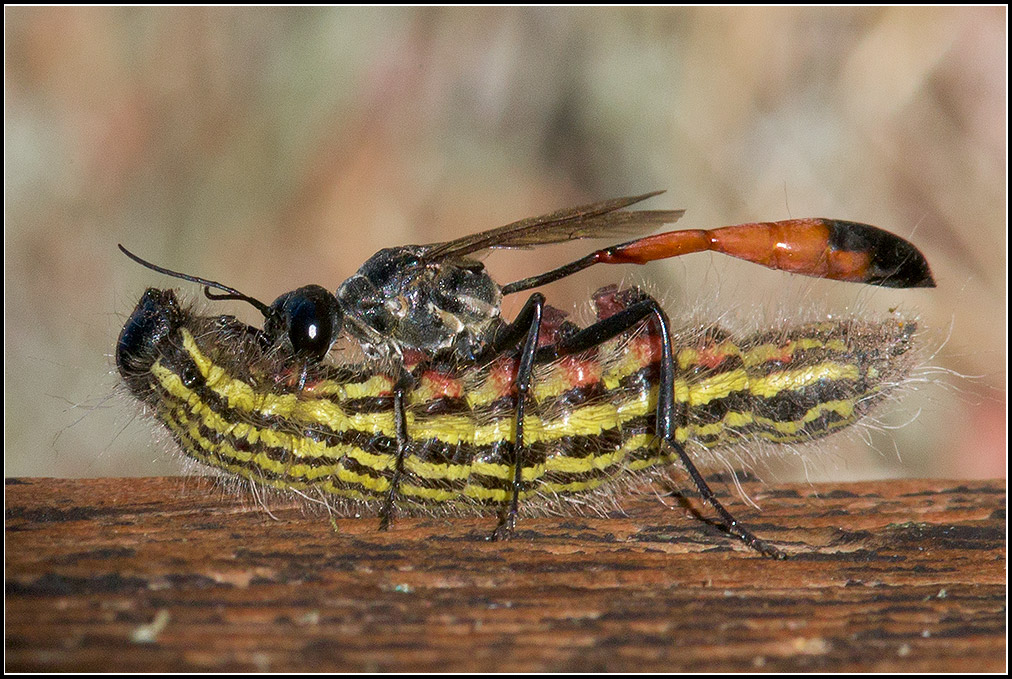
Every now and then, I just discuss a photo, and the story behind it. Today is one of those times.
This is a thread-waisted wasp (Ammophila sp.) and a spotted datana caterpillar (Datana perspicua).
How did I find this photo opportunity? I was on a photo trip through the Southwest, with my friend, Ron. We went to Dinosaur National Monument, in Colorado. We just pulled into the visitor center parking lot, stepped out of the car, and there was this life and death drama unfolding in front of us, on the empty tarmac lot.
I photographed it with my 300 f/4 IS lens, with a 1.4x extender on it. Why did I choose that lens? It was simply a matter of expediency. We found this wasp and caterpillar, and we had no idea how long this photo opportunity would last – so we wanted to start shooting without wasting any time, to minimize the risk of losing the opportunity. This lens was already on my camera, and so this was the lens I chose.
In retrospect, the 300 f/4 was probably my best lens choice for this, anyway. My 180 f/3.5 macro lens would’ve allowed much closer focus on these small creatures, but for that kind of close focus, it would’ve been best to use a tripod, and focus manually. This wasp was on the move, and fiddling with my tripod and focus ring while trying to follow it would’ve been sub-optimal. The 300 may not focus as close, but it focused close enough to allow for a cropped photo of a decently usable size. Meanwhile, its lens stabilization, and fast autofocus allowed me to put my efforts primarily into positioning myself well, in relationship to the subject. If I’d had more time to carefully choose the lens, the only difference I’d make would’ve been to switch the 1.4x extender for a 2x extender.
To my relief, the wasp quickly left the parking lot, thereby allowing for a a nicer background than pavement. However, the shooting conditions were difficult. The wasp was moving surprisingly fast, dragging the caterpillar back to its lair, and not stopping for even a moment. It was wandering through thick underbrush, making it difficult to even find, at times. We lost them, and re-found them, repeatedly, in the dense brush. There were constantly twigs and leaves breaking up my view of the wasp and caterpillar. The light was very uneven, with bright sun and splotches of dark shadow, everywhere.
We followed them around the brush, for half an hour, waiting for a break in the vegetation, waiting for the wasp to slow down or stop for a moment. Due to the direction of the sun, we had to “follow” from in front, staying ahead of where we anticipated the wasp would go. Otherwise, we’d have to shoot it from the shadow side, which would not likely have worked well in these conditions. “Following” from in front was not working well, because the wasp was making all kinds of seemingly random twists and turns through the underbrush.
Finally, the wasp climbed up on an old fencepost, and came to rest. I tried to compose with a clean background and good light. I tried to find an angle that showed both creatures clearly, without blocked areas nor visual confusion. We got our shots. Then the wasp moved on, again, and Ron and I went to the Dinosaur National Monument visitor center. The visitor center was closed, but we found another thread-waisted wasp, with another spotted datana caterpillar, on the concrete sidewalk, outside the visitor center. We got some very clear documentary shots of them there, but the concrete background is not to my taste. Within the next few minutes, we discovered that there were many spotted datana caterpillars crossing the open pavement, and many thread-waisted wasps, catching them. It was quite the spectacle.
So, what exactly is going on, in this picture? As far as I’ve been able to determine: The wasp had paralyzed the caterpillar with a sting, but had not killed it. These wasps then drag the caterpillars back to their lairs. There, they lay eggs in the live caterpillars. As the wasp larvae grow, they eat the caterpillars alive, from the inside. Eventually, they burst out of the half-dead caterpillars – and then the caterpillars (whose “minds” have been addled by the wasp larvae) will use their own silk to build cocoons for the wasp larvae, and then will stand over the cocoons and defend them, until starving to death.
But this parasitism story goes even beyond this. Since I wasn’t familiar, I didn’t know to look for this, at the time: There was probably a satellite fly (Miltogramminae sp.), hovering close nearby. Their “satellite” name actually comes from their hovering around the thread-waisted wasps. These flies lay their eggs near the entrances of the wasps’ dens. When the satellite fly larvae hatch, the make their way down into the wasps’ dens. If they can, the fly larvae (which hatch faster than the wasp larvae) will eat the caterpillar, first. In the process, they’ll perhaps even devour the wasp larvae. Thus, there’s a story of multiple layers of deadly parasitism, behind this picture.
Thread-Waisted Wasp (Ammophila sp.) and Spotted Datana Caterpillar (Datana perspicua), Dinosaur National Monument, Utah
All pictures and text are © Mike Spinak, unless otherwise noted. All pictures shown are available for purchase as fine art prints, and are available for licensed stock use. Telephone: (831) 325-6917.